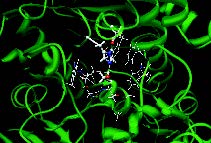Sample QM/MM layering of acetylcholinesterase
Ohio State University chemistry professor Christopher Hadad, Ph.D., is developing measures that will stop, or even prevent, the effects of lethal chemical warfare agents such as the nerve agent sarin. At the center of his research are organophosphinates (OPs), extremely toxic chemicals that attack the central nervous system and can cause deadly convulsions.
“Because the body continuously processes enzymes, the challenge will be to create a broad spectrum bioscavenger enzyme that is stable in the blood, stays in the body for a period of time, and can process the OPs before they affect a person’s nervous system,” Dr. Hadad said. “Our goal is to develop one or two biological agents that will improve protection against nerve gas poisoning for soldiers and first responders, and, eventually, serve as a vaccine.”
In the first year of this five-year grant, the team extensively turned to the supercomputing resources at the Ohio Supercomputer Center. To illustrate: they used molecular dynamics simulations to study how particular chemicals bind to the catalytic serine, a common amino acid, and Dock 6.0, a program that predicts how OPs bind with the human enzyme paraoxonase.
They’ve also used Quantum Mechanical/Molecular Mechanical methods to split calculations of the OP reaction process into layers, which greatly improves accuracy. These computationally intensive calculations model the complete reactive system by using an expensive, yet accurate, level of theory for the active site domain of the enzyme, while using a cheaper, and less accurate, molecular mechanics methodology to consider the entire enzyme’s structure. The hybrid method provides a study of the complete system without relying on smaller model systems – an aspect especially important for the development of a true bioscavenger.
--
Project Lead:
Christopher Hadad, Ph.D.,
The Ohio State University
Research Title:
Mechanistic, Kinetic, Spectroscopic and Computational Evaluations of OP Hydrolysis Activity
of Enzymes
Project Team:
• David Lenz, U.S. Army
• Christopher Hadad, Ph.D.,
The Ohio State University
• Thomas Magliery, Ph.D.,
The Ohio State University
• Terry Gustafson, Ph.D.,
The Ohio State University
• Matthew Platz, Ph.D.,
The Ohio State University
Funding Source:
National Institutes of Health, through the U.S. Army Medical Research Institute of Chemical Defense
For more information:
